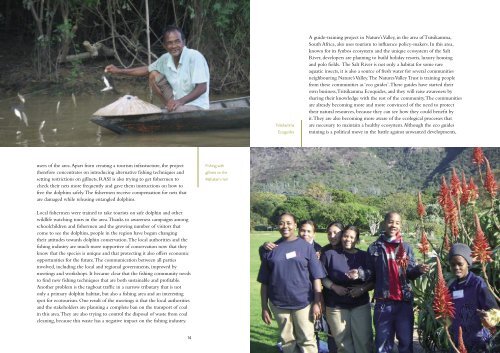OMSLAG 5.indd - IUCN
OMSLAG 5.indd - IUCN
OMSLAG 5.indd - IUCN
Create successful ePaper yourself
Turn your PDF publications into a flip-book with our unique Google optimized e-Paper software.
users of the area. Apart from creating a tourism infrastucture, the project<br />
therefore concentrates on introducing alternative fishing techniques and<br />
setting restrictions on gillnets. RASI is also trying to get fishermen to<br />
check their nets more frequently and gave them instructions on how to<br />
free the dolphins safely. The fishermen receive compensation for nets that<br />
are damaged while releasing entangled dolphins.<br />
Local fishermen were trained to take tourists on safe dolphin and other<br />
wildlife watching tours in the area. Thanks to awareness campaigns among<br />
schoolchildren and fishermen and the growing number of visitors that<br />
come to see the dolphins, people in the region have begun changing<br />
their attitudes towards dolphin conservation. The local authorities and the<br />
fishing industry are much more supportive of conservation now that they<br />
know that the species is unique and that protecting it also offers economic<br />
opportunities for the future. The communication between all parties<br />
involved, including the local and regional governments, improved by<br />
meetings and workshops. It became clear that the fishing community needs<br />
to find new fishing techniques that are both sustainable and profitable.<br />
Another problem is the tugboat traffic in a narrow tributary that is not<br />
only a primary dolphin habitat, but also a fishing area and an interesting<br />
spot for ecotourism. One result of the meetings is that the local authorities<br />
and the stakeholders are planning a complete ban on the transport of coal<br />
in this area. They are also trying to control the disposal of waste from coal<br />
cleaning, because this waste has a negative impact on the fishing industry.<br />
Fishing with<br />
gillnets on the<br />
Mahakam river<br />
Tsitsikamma<br />
Ecoguides<br />
14 15<br />
A guide-training project in Nature’s Valley, in the area of Tsitsikamma,<br />
South Africa, also uses tourism to influence policy-makers. In this area,<br />
known for its fynbos ecosystem and the unique ecosystem of the Salt<br />
River, developers are planning to build holiday resorts, luxury housing<br />
and polo fields. The Salt River is not only a habitat for some rare<br />
aquatic insects, it is also a source of fresh water for several communities<br />
neighbouring Nature’s Valley. The Natures Valley Trust is training people<br />
from these communities as ‘eco guides’. These guides have started their<br />
own business, Tsitsikamma Ecoquides, and they will raise awareness by<br />
sharing their knowledge with the rest of the community. The communities<br />
are already becoming more and more convinced of the need to protect<br />
their natural resources, because they can see how they could benefit by<br />
it. They are also becoming more aware of the ecological processes that<br />
are necessary to maintain a healthy ecosystem. Although the eco guides<br />
training is a political move in the battle against unwanted developments,
















